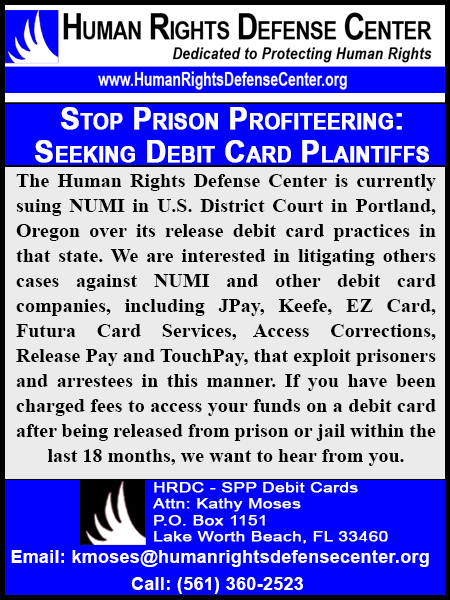Eleventh Circuit Announces Defendant Must Know Leaving Residential Facility Without Permission Is ‘Unlawful’ for Escape Conviction Under 28 U.S.C. § 4082(a)
by Matt Clarke
The U.S. Court of Appeals for the Eleventh Circuit reversed a federal criminal defendant’s escape conviction for leaving a residential reentry facility without authorization after holding that, contrary to the positions of both the U.S. District Court for the Northern District of Florida and the prosecutor, the Government was required to prove that the defendant knew his conduct was “unlawful” when he left the facility in order to secure a conviction under 28 U.S.C. § 4082(a).
Frederick Bush left the Keeton Residential Reentry Center in Tallahassee, Florida, before his required term had expired. He was indicted for a single count of “knowingly escap[ing] from custody … by willfully failing to remain within the extended limits of his confinement and failing to remain at” Keeton. Importantly, the indictment cited both § 751(a) and § 4082(a), which states that the “willful failure of a prisoner to remain within the extended limits of his confinement, or to return within the time prescribed … shall be deemed an escape.” (emphasis supplied)
Representing himself at trial, Bush testified that Keeton employees had mistreated him and his family and retaliated against him, which caused him to leave the facility in a state of mental distress and without the knowledge that he was committing a crime or the intent to commit a crime. He also testified that he would not have left the facility had he known he was committing a crime by doing so.
The District Court repeatedly interrupted Bush and his witnesses to advise the jury that all the prosecution had to prove was whether Bush “was lawfully in the custody of a federal facility, whether he left the facility knowing that he didn’t have permission and wasn’t allowed to leave.” That is, the court instructed the jury that it was irrelevant whether Bush knew his leaving the facility without permission was “unlawful.”
Bush objected to the court’s proposed instructions, arguing “that the offense’s knowledge element required proof that he knew his conduct amounted to escape,” i.e., that his actions were “unlawful.” The court responded by saying, “You are wrong about that, and you can tell it to the appellate court.”
Following his conviction, sentencing, and the appointment of Tallahassee Federal Public Defender Joseph DeBelder to represent him on appeal, Bush did just that. The Eleventh Circuit did not rule on whether the standard of review should be de novo or for plain error because it determined that Bush could satisfy both standards.
The Court observed that, § 751(a) prohibits an “escape or attempt to escape from … custody” and requires only proof that “a defendant knew his actions would result in his leaving physical confinement without permission.” Unites States v. Bailey, 444 U.S. 394 (1980). However, the indictment cited both § 751(a) and § 4082(a) in a single count. That required the prosecution to prove the elements of both offenses to obtain a conviction, and § 4082(a) requires that Bush’s actions be “willful.”
The Court noted that it’s never addressed the “willful” requirement in § 4082(a), but there is guidance on the use of that term in the statute in other contexts. In a Fifth Circuit case involving the sufficiency of the evidence under § 751(a) and § 4082(a), the court explained that the prosecution “must show that the accused failed to return ‘knowingly,’ ‘willfully,’ and ‘unlawfully.” United States v. Brackett, 582 F.2d 1027 (5th Cir. 1978). Similarly, the U.S. Supreme Court has addressed the term “willful” in other contexts and statutes and has held that although willfulness doesn’t require that the defendant was aware of the specific statute he was violating, it does require proof that he was aware that his conduct was unlawful. Bryan v. United States, 524 U.S. 184 (1998). Finally, the Eleventh Circuit Pattern Jury Instructions define a “willful” act as one “committed voluntarily and purposely, with the intent to do something that law forbids; that is, the bad purpose to disobey or disregard the law.” Pattern Crim. Jury Instr. 11th Cir. BI B9.1A (2020).
Based on the foregoing sources, the Court concluded that under § 4082(a), “willful” requires that the prosecution prove the defendant acted “unlawfully.” The Court determined that the District Court’s jury instruction failed to include the necessary mens rea element of the offense by failing to specify that Bush must have had the intent to act unlawfully when he left the facility without permission. Thus, the Court held that the District Court erred and that the error was plain. Neder v. United States, 515 U.S. 506 (1995) (stating that “a jury instruction that omits an element of the offense” charged is indisputably “error”). The Court further held that the erroneous jury instruction was likely responsible for an “incorrect verdict.” United States v. Whyte, 928 F.3d 1317 (11th Cir. 2019) (explaining plain error standard, i.e., “(1) error, (2) that is plain, and (3) that affects substantial rights”).
Accordingly, the Court vacated and remanded for a new trial. See: United States v. Bush, 110 F.4th 1246 (11th Cir. 2024).
As a digital subscriber to Criminal Legal News, you can access full text and downloads for this and other premium content.
Already a subscriber? Login





